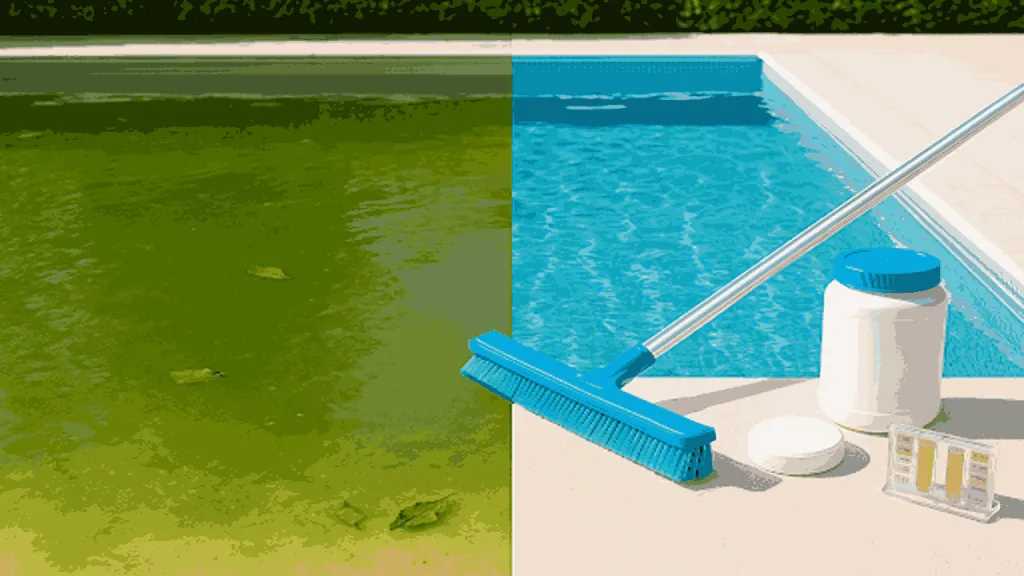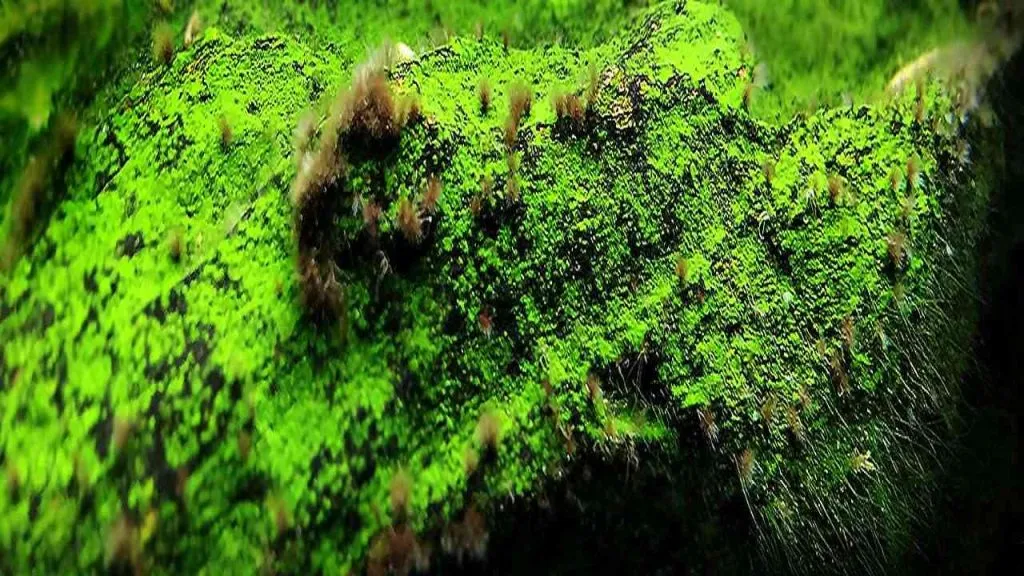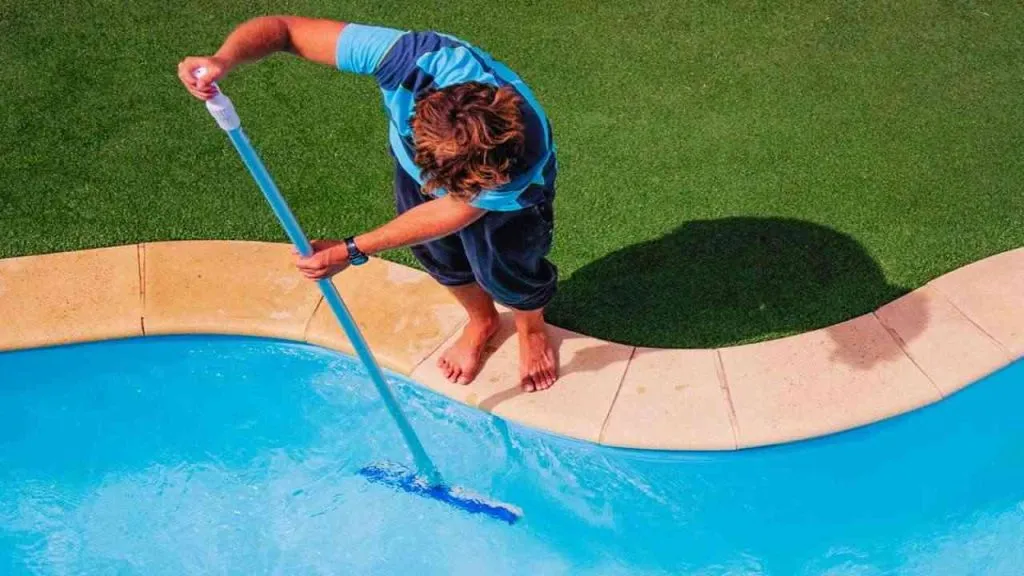As an Amazon Associate I earn from qualifying purchases.
If you’ve ever found your pool murky, green, or covered in strange-colored patches, that’s algae. And yes, it’s as annoying as it looks.
Algae is one of the most common and frustrating pool problems. One day, your water is sparkling, the next, it’s pea soup. And the big question pool owners ask is: Does chlorine kill algae?
The short answer is yes… but there’s more to it.
Algae is slippery, unsafe, and makes your pool water unhealthy. While chlorine is your main defense, killing algae isn’t just about dumping chemicals into the stagnant water.
There’s a strategy to it, from maintaining balance water levels to proper circulation and smart pool algae prevention techniques.
This guide will help you remove algae if you already have it, or prevent it from ever coming if you don’t.

Understanding Algae in Swimming Pools
Algae is a common type of problem during warm temperatures, and it can get out of hand fast if not treated properly.
But not all type of algae are the same, and neither are the ways to remove them.
A. Types of algae: green/blue, yellow/mustard, and black
Algae come in a few varieties, and each behaves a little differently. Here’s a quick breakdown:
| Algae Type | What It Looks Like | Where It Grows | How Hard Is It to Remove |
| Green Algae | Bright green water or slimy film | Pool walls, steps, floating in the pool | Fairly easy |
| Yellow (Mustard) Algae | Dusty yellowish coating | Shady areas, corners, behind ladders | Moderate |
| Black Algae | Stubborn dark or black spots with tough roots | Cracks, grout lines, rough surfaces | Very tough |
Knowing the type of pool algae helps you pick the right approach, whether it’s a chlorine pool shock, stiff brushing, or backup treatments like algaecides.
B. Factors Contributing to Algae Growth
Algae needs the right conditions to thrive; unfortunately, pools often give it exactly what it wants.
Here are some common triggers:
- Low chlorine levels: Not enough sanitizer means algae can grow unchecked.
- Poor circulation: Dead spots in the water create a cozy environment.
- Unbalanced water level chemistry: Especially if phosphate levels or nitrates are high.
- Warm temperatures or weather: Heat speeds up algae growth dramatically.
- Debris: Leaves, dirt, and bugs add nutrients that algae feed on.
- Heavy pool use: More swimmers = faster chlorine depletion.
Even missing one cleaning session or letting liquid chlorine dip for a day or two can invite forms of algae to take over, especially in the heat of summer.
C. Risks Posed by Algae in Pools
A green or slimy pool isn’t inviting, but the risks go beyond the surface.
- Health concerns: Algae can attract E-coli bacteria, leading to skin and ear infections.
- Safety hazards: Slippery steps and ladders are accidents waiting to happen.
- Strained equipment: Algae clogs pool filters and makes pool pumps work harder.
- Pool Chemical imbalance: Dead algae consume chlorine, making it harder to keep levels steady.
- Damage to surfaces: Black algae, especially, can ruin plaster and tile grout if left too long.
Now that you know what you’re up against, let’s explore how chlorine helps you remove the source for algae.
The Role of Chlorine in Algae Control

Chlorine can be your primary tool for algae removal in pools. But how it works, how much you need, and when to use it make all the difference.
Let’s break it down.
A. Chlorine as a Sanitizer and Oxidizer
Chlorine does more than make your pool smell “clean.” It does two important things when it comes to swimming pool algae bloom control:
- Sanitizing – It kills bacteria, viruses, and algae spores before they multiply.
- Oxidizing – It breaks down organic contaminants (like sweat, sunscreen, and leaves) that algae feed on.
This two-in-one power makes pool chlorination such a reliable method in algae prevention. But only if your chlorine levels are right.
B. Optimal Chlorine Levels for Algae Prevention
To keep algae from gaining a foothold, your free chlorine level needs to stay within an effective range:
| Chlorine Type | Target Level | Purpose |
| Free Chlorine (FC) | 2.0 – 4.0 ppm (daily) | Active sanitizer that kills algae |
| Combined Chlorine | < 0.5 ppm | Should stay low; high means chlorine is “used up” |
| Total Chlorine | FC + CC = Total Chlorine | Used to monitor chemical level balance |
If FC drops below 2 ppm, you’re at risk environment for algae. This is why consistent pool maintenance is so crucial; test daily if you’ve had algae before.
Pro tip: Use a digital test kit for accuracy. Cheap test strips often miss the mark.C. Shocking the Pool: Different Types and Their Effectiveness
Here’s how to match the shock type to your needs:
| Shock Type | Best For | Notes |
| Calcium Hypochlorite Shock | Green algae outbreaks | Strong, quick, but raises calcium levels |
| Sodium Dichlor | Daily maintenance for mild cases | Dissolves slowly, contains stabilizer |
| Lithium Hypochlorite | Vinyl liner pools | Dissolves quickly, doesn’t add calcium |
| Non-Chlorine Shock Treatment (MPS) | Light oxidation, not algae removal | Won’t kill algae, use as a maintenance tool only |
For green pool solutions, use Cal-Hypo at night and brush immediately. For yellow or mustard algae, double dose and scrub all shaded areas.
Black algae require a triple dose of shock with brushing, and often a quality pool algaecide alternative.
Always follow up with brushing and filter cleaning. Dead algae stay suspended unless physically removed.
So, does chlorine kill algae? Absolutely! But only if you’re using it correctly.
Next: let’s walk through the complete step-by-step algae removal process, from water testing to vacuuming, and everything in between.
Comprehensive Algae Removal Process

With a methodical approach and the right pool cleaning tools, algae removal becomes completely manageable.
Below is your step-by-step, no-fluff guide to getting your pool sparkling clean again.
Step 1: Testing and Balancing Water Chemistry
Before you attack the algae, ensure your pool water is ready for battle. Use a liquid drop test kit or digital reader to check:
- pH (ideal: 7.2–7.6)
- Alkalinity (ideal: 80–120 ppm)
- Cyanuric Acid Levels (CYA) (ideal: 30–50 ppm)
- Free Chlorine (FC) (should be below 1 ppm before shocking)
A pH that’s too high weakens pool chlorine, making it harder to kill algae. Your water balance ensures your shock treatment works at full strength.
Step 2: Brushing, Vacuuming, and Debris Removal
Algae cling to pool surfaces like glue. That means physical removal is just as important as chemical treatment.
- Brush every surface, including walls, pool floor, steps, and behind ladders
- Use a pool vacuum to suck up loosened algae
- Skim floating debris and clean out your skimmer basket
Repeat this process daily until the algae is completely gone.
For stubborn black algae growth, use a steel-bristle stiff pool brush on concrete pools, as it penetrates the protective biofilm layer.
Step 3: Running the Pump and Cleaning Filters
Filtration is your best friend when dealing with suspended dead algae. You need to keep the water moving and the gunk out.
- Run the pump 24/7 during the treatment process
- Backwash or clean your filters daily
- Filter Cartridges: Remove and spray down thoroughly
- Sand Filters: Backwash until clear
- DE Filters: Recharge after cleaning
Tip: Algae can clog filters fast. Monitor pressure and clean as needed to prevent re-contamination.Step 4: Shocking the Pool Over Time with High Chlorine Doses
This is where you hit algae hard with pool chlorination.
| Algae Type | Shock Strength (FC ppm) | Chlorine Type |
| Green Algae | 10–30 ppm | Calcium Hypochlorite |
| Yellow/Mustard Algae | 30–40 ppm | Sodium Dichlor or Cal-Hypo |
| Black Algae | 40+ ppm | Multiple rounds of Cal-Hypo |
- Shock after sunset to reduce UV loss
- Pour slowly around the pool perimeter
- Brush immediately after dosing
Note: Always wear gloves and eye protection when handling shock.Step 5: Using Flocculants and Preventative Algaecides
When shock alone doesn’t finish the job, flocculants and algaecide alternatives come into play.
- Flocculants clump dead algae, making it easier to vacuum
- Use a polyquat 60 algaecide, a non-metallic option safe for most pools
- For natural algae treatment, baking soda and hydrogen peroxide can assist light outbreaks (though not a replacement for chlorine demand)
| Treatment | Best Use Case | Note |
| Flocculants | Cloudy water with dead algae | Vacuum to waste after use |
| Algaecides | Persistent or yellow algae | Avoid overuse, can cause foaming |
| Baking Soda | Minor green color algae prevention | Helps stabilize pH |
Pool maintenance is all about consistency. But it comes with its challenges, let’s see how to handle them next.
Challenges in Algae Management
Keeping a pool algae-free sounds simple, but it’s not always easy. Several issues can throw off even the best pool care routines.
Here’s a breakdown of the most common obstacles and how to overcome them.
A. Incorrect Dosage and Poor Pool Chemistry of Water
Chlorine only works well when conditions are right. For example:
- High pH makes chlorine far less effective.
- Low free chlorine means there’s not enough sanitizer to kill algae.
- Too much organic debris can “eat up” your chlorine before it reaches the algae.
Quick fix:
- Test the water regularly.
- Keep pH between 7.2 and 7.6.
- Shock the pool when needed to restore sanitizer levels.
B. High Cyanuric Acid (CYA) Levels
When CYA levels climb too high, chlorine becomes less available to do its job, especially when dealing with algae blooms.
Signs of high CYA:
| CYA Level | Impact on Chlorine |
| 30–50 ppm | Ideal range |
| 70+ ppm | Weakens chlorine |
| 100+ ppm | Time to dilute |
If your CYA is high, partially drain and refill your pool with fresh water. It’s a key step in effective algae removal in pools and better long-term pool chlorination.
C. Inadequate Circulation
Areas with weak circulation, like pool steps, corners, or behind ladders, become perfect breeding grounds.
If chlorine isn’t moving through the entire pool, it can’t reach these dead zones.
Tips to improve poor water circulation:
- Run the pump for 8–12 hours per day (or longer during outbreaks).
- Angle your return jets to push water in a circular motion.
- Brush the pool with algae regularly to stir up hidden algae.
- Clean skimmer baskets and filters often.
Good circulation makes all the difference in swimming pool algae control.
D. Resistant Pool Algae Strains
Some types of algae, like mustard or black algae, are stubborn and harder to kill. They form protective layers or burrow into pool surfaces, making them resistant to regular chlorine levels.
What helps:
- Mustard algae: Use a mustard-specific algaecide or raise chlorine levels for 24 – 48 hours.
- Black algae: Requires aggressive brushing, extra shock, and sometimes metal-based treatments.
- Natural algae treatment options: Baking soda can help loosen visible algae and adjust pH, but won’t kill it. It’s best used as a support, not a replacement.
If standard methods aren’t cutting it, consider green pool solutions combining higher chlorine doses with thorough cleaning and proper filtration.
You can get rid of algae, but what if it comes back? Let’s look at some preventive measures to ensure your pool party stays uninterrupted and algae-free..
Preventive Measures for Algae-Free Pools

The right habits can keep algae out of your pool for good. Prevention is easier and far cheaper than a full-blown green pool recovery.
Here’s what consistent algae prevention looks like.
A. Maintaining Proper Chlorine Levels
Chlorine sanitizes your pool and actively prevents algae from taking hold.
Target chlorine levels:
- 1–3 ppm for daily maintenance
- 5–10 ppm for shocking or after heavy use
Pro tip: Test your water at least 2–3 times a week, especially after rain or lots of swimmers. This keeps your sanitizer in check and makes chlorine and algae an unbeatable combo.B. Regular Shocking and Use of Algaecides
Even with good daily care, organic contaminants can build up and make chlorine less effective. That’s where regular pool shocking comes in.
When to shock your pool:
- After heavy use or a rainstorm
- Once every 1–2 weeks as part of routine pool maintenance
- If chlorine levels drop or algae start to appear
As for algaecides, they’re best used as a preventive tool, not a cure. Many swimming pool owners find success with natural algae treatment options like copper-based algaecides or enzymes, but always follow label instructions and never rely on them alone.
C. Ensuring Adequate Water Circulation
Good circulation spreads chlorine throughout the poo,l preventing pockets where algae can grow unnoticed.
Make sure to:
- Run your filter for at least 8 hours daily
- Clean or backwash your dirty filter regularly
- Point return jets to circulate water into corners and low-flow areas
If your pool has steps, ledges, or built-in features, ensure those areas get special attention; poor flow there can quickly lead to algae growth.
D. Consistent Brushing and Monitoring of Water Chemistry
Brushing the pool is one of the easiest ways to keep surface algae-free.
Weekly brushing breaks up biofilms and stops algae from gaining a foothold, especially on plaster, tile, or concrete surfaces.
Pair brushing with consistent testing to keep the level of pool water pH, alkalinity, and chlorine in the ideal range:
| Parameter | Ideal Range |
| pH | 7.2 – 7.6 |
| Free Chlorine | 1 – 3 ppm |
| Total Alkalinity | 80 – 120 ppm |
These simple steps can go a long way toward swimming pool algae control and help you avoid costly, time-consuming cleanups down the road.
But if chlorine alone is insufficient, other methods, including natural ones, can help you.
Supplementary Treatments and Natural Methods
When chlorine alone is not enough to keep your pool clean, you might need some help from natural methods.
Here’s how to reinforce your pool’s defense system without relying solely on harsh pool chemicals.
A. Algaecides as Complementary Treatments
Algaecides can help prevent blooms, especially during hot, rainy, or high-traffic periods. But they shouldn’t replace your regular sanitizer.
Best practices:
- Use as a preventive measure, especially after shocking
- Rotate or alternate algaecide types to avoid resistant strains
- Try algaecide alternatives like copper-based or enzyme-based products for gentler options
These treatments help target spores that chlorine may miss, especially in shaded or low-flow areas.
B. Sunlight Exposure and Baking Soda for Prevention
Sunlight can work in your favor. UV rays help reduce some algae types naturally by heating and sanitizing the water.
You can also try a simple, natural algae treatment: baking soda.
- It raises alkalinity without dramatically affecting pH
- When used correctly, it can make the pool environment less friendly to algae
- Great for brushing into corners, steps, and other trouble spots
Just don’t overdo it; always test your water clarity after applying baking soda to maintain balance.
C. Balancing Chemical Treatments with Natural Approaches
Not every pool needs a fully “chemical-free” approach, but you can be smart about reducing dependency on harsh treatments.
Tips for a more balanced approach:
- Use enzymes or clarifiers to break down organic material waste naturally
- Consider a UV or ozone system to assist with sanitization
- Focus on routine maintenance to avoid crisis-level algae in pools
- Keep swimmers clean, shower before entering to reduce contaminants
Using chlorine and algae control methods in harmony with natural solutions helps maintain a healthier, safer pool for everyone.
Conclusion
Dealing with pool algae doesn’t have to be a constant battle. By understanding what causes algae growth and using a mix of smart pool maintenance, proper chlorination, and natural algae treatments, you can keep your pool clean and inviting all season long.
Whether handling a green pool crisis or just looking to improve your swimming pool algae control routine, prevention is always easier than a cure.
Stay consistent, stay informed, and enjoy a crystal-clear swim without the stress.
Amazon and the Amazon logo are trademarks of Amazon.com, Inc, or its affiliates
